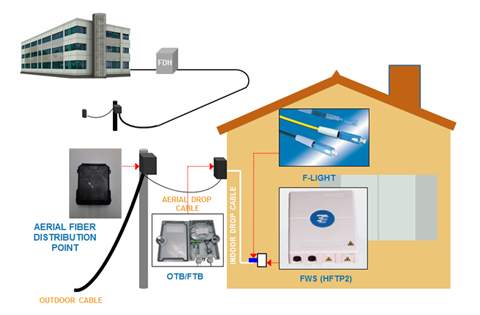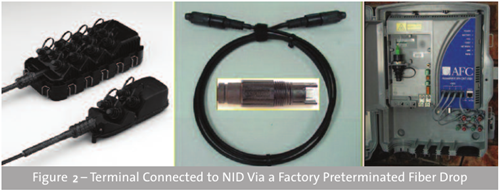Fiber to the home (FTTH) developments clearly influence the demand for today’s home purchases. Developers and home builders recognize the need for reliable high-speed broadband communications. Thus they should seize the opportunity to design FTTH network during the design and construction of the development. In fact, deploying FTTH in a new development is at cost similar with deploying copper at the same location. But the long-term benefits stemming from fiber-ready infrastructure further catch people’s attention. Unlike coax and xDSL, fiber is more than just fast. So why implement FTTH development? The following article will give a further illustration of the reasons.
Fast Bandwidth
Cable modem and xDSL helped residential broadband get off the ground. Now, however, the sheer speed of fiber overcomes bandwidth limitations of coax and copper. To illustrate, rising consumer demand for big-screen LCD displays can chew up 19 Mbps of bandwidth per channel. In addition, broadband connections are constantly clamoring for more band-width, both upstream and downstream. With busier lives, families want high-speed broad-band communications to transfer e-mail, digital photos and Internet files and they also want entertainment options such as time-sensitive, interactive video gaming that requires bi-directional bandwidth capability. With the typical household having three or more TVs and the ferocious appetite of broadband vying for capacity, it is easy to see that an abundant supply of fiber bandwidth must be included in the design and construction of the development. Figure 1 shows the basic FTTH architecture.

Reliable Capacity
Noisy channel conditions, inclement weather, environmental clutter such as buildings and trees, corroded connections and distance limitations can all impact the reliable delivery of residential broadband. However, the FTTH network access architecture is immune to all of these conditions so there is virtually no downtime. In addition, economical battery backup at the residential NID automatically kicks in when line power is interrupted. Furthermore, FTTH assures the demanding subscriber that they always receive the high-speed broadband capacity that they are paying for, both upstream and downstream, no matter how loaded the access network may be. This built-in reliability is no longer the exception but rather what the homeowner now expects and the builder’s life becomes much easier with satisfied homeowners.
Easy Deployment
Making the optical channel ready for signals once required a skilled technician to carefully splice fiber cables together. Today, the success of FTTH is no longer tied to fiber splicing in the field. As already alluded to, the distribution and drop segments of the FTTH network are easily deployed and intuitively connected. For example, the preterminated fiber drop can reduce subscriber connection time by up to 50 percent because it can be easily screwed into the terminal and the NID by an installer who does not need to know anything about fiber. In the distribution segment, the ease of deployment can shave off 80 percent of the deployment time, because once the terminal distribution system has been placed, homes are immediately ready to be connected into the network.

In addition, with FTTH, there is no need for high-voltage power supplies in the neighborhood. Manufacturers are also continuing to improve the appearance and reduce the size of fiber cabinets and terminals relative to the traditional copper products. Combined, this results in a much more aesthetically pleasing deployment than ever before.
Future Proofing
An FTTH network offers land developers an enviable return on their investment capital. Timely planning today can net thousands of dollars in profit. For example, if you invest $500 per home to deploy the fiber jumper and connecting hardware and the home then sells for $5,000 more than it would have otherwise, your investment just returned a handsome 1000 percent profit. That is easy math and easy money.
The return on fiber investment does not stop with its deployment, however. The network operator will also appreciate that robust, reliable and cost-effective FTTH network as they seriously consider their operational expenses. For example, an optical access network featuring segments that can, by design, be quickly connected together not only reduces the upfront deployment cost but also will reduce the amount of time required to turn up subscribers, test and troubleshoot the network. As the triple-play battle for the residential customer continues, a preterminated FTTH network can make the business case very enticing because it sets the network operator’s stage for reduced operational costs and additional revenue from advanced services such as home security and home networking.
Operationally, fiber drop cables are quickly and easily screwed into terminals and residential network interface devices (NID) across the country to save both time and money. Without these key advances in FTTH technology that reduce capital and operational costs, FTTH would continue to wrestle its competitors but now FTTH wins the access investment hands down.
Beneficial Solution
Modern day residential services like HDTV and high-speed broadband that enhance the quality of life in homes are being delivered via FTTH. Looking forward, FTTH residential developments ensure that advanced services such as telecommuting, telemedicine and distance learning will all be transparently realized. FTTH results in reduced commutes and environmental pollution, prolonged quality of life, and education, education, education. Broadband communications is a key element in an increasingly competitive global economy. With FTTH, the world will be better positioned for social and economic prosperity.
Summary
To sum up, FTTH deployment is unstoppable with all the positive impacts that fiber affords. If you are still waiting for service providers to install cable and manually turn up services, then you are left behind. Fiberstore provides a full range of fiber jumper cables suitable for FTTH deployment. MM fiber patch cords and single mode fiber patch cables are also available. Come to us if you have any request for our products.

Thank you for sharing the information.
ReplyDeletePassive Networking
Structured Cabling
Thank you for the information Fiber optic network cabling
ReplyDelete